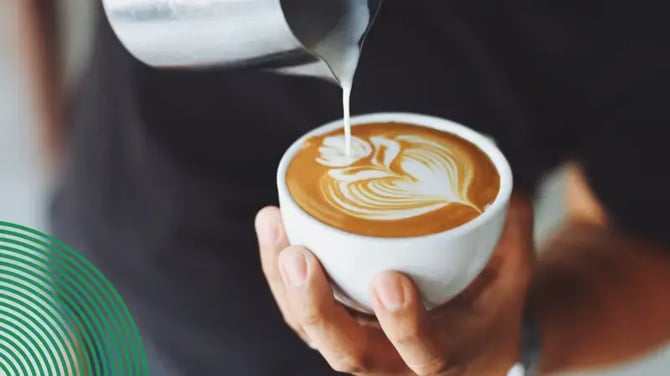Particularly in these days of economic instability and persistent food inflation, coffee shop inventory management is every bit as complicated as that of a fine dining establishment or a corporate chain.
In the beverage industry, coffee is still king.
- Over the past 24 hours, 65% of Americans have drank coffee more than any other beverage.
- In the UK alone, 98 million cups of coffee are enjoyed each day.
- US coffee and snack shops surged 3.3% in 2024, hitting 72,854.
Therefore, it’s imperative to have proper inventory management because of the enormous upside possibilities.
Continue reading to learn how implementing an inventory strategy for your coffee business may boost sales, cut down on waste, and maintain a positive atmosphere.
%20(1).webp?width=800&height=450&name=Eat%20(42)%20(1).webp)
What is inventory management for coffee shops?
The process of ensuring that your inventory meets consumer demand is known as coffee shop inventory management. The ultimate objective is to have the ideal level of inventory so that you never run out of a product, have too much on hand, and waste not selling any of it.
.webp?width=800&height=450&name=4%20(1).webp)
Breakdown of inventory management terms
Understanding the global scope of coffee shop inventory requires familiarity with a few key terms:
- First up, the term COGS. The whole cost of all the items a coffee shop uses in a specific amount of time, including food, sugar, coffee beans, and even the cost of the to-go cups and other paper supplies, is known as the cost of goods sold, or COGS. Utilize the following easy formula to determine your COGS: Starting stock plus purchased stock equals ending stock. COGS should, as a general rule of thumb, be approximately 25% of your total sales.
- The term "par level" describes the bare minimum of supplies you should have on hand to guarantee that you consistently satisfy the needs of your clients.
- Now, what are plate prices? Tracking the unit of measurement that the materials were purchased in (ounces, pounds, gallons, cases, etc.) is the first step towards understanding plate prices. The difference between price and cost, or plate costing, is computed using the following formula: profit margin percentage = ([Price – Cost]/Price)*100.
- What’s “unit conversion”? Converting ingredients between various weight and volume units is known as unit conversion. For example, you will need to know how to measure the liquid capacity of a bag of coffee beans.
- Understand the meaning of yield. After processing, the yield is the quantity of product that is still useful. An in-house bacon-making breakfast establishment, for instance, will find that its raw pork belly weighs far more than its actual yield after curing and cooking.
- Costs for recipes must also account for waste that arises during food and beverage preparation.
- The meaning of AvT? The difference between the actual and theoretical costs of items sold, as determined by forecasts from historical data, is known as the actual versus theoretical formula (AvT). Another name for this is variance.
- What’s depletion? The amount of time you have, until a product runs out completely, is called its depletion.
- And a count sheet? The spreadsheet you use to monitor your physical inventory is called a count sheet.
Now, for shelf-to-sheet. Looking at what's on your shelf and comparing it to your inventory sheet is known as shelf-to-sheet inventory tracking.
Now that you have the terms and meanings in the bag, let’s take a look at why it’s necessary for you and your team to do coffee shop inventory management.
Further reading
The importance of inventory management
For coffee shop inventories, intentionality is key, meaning timely (and precise) information is absolutely essential.
For coffee shop managers to precisely determine the expenses of each item sold, everything from stirrers to filters to the caramel drizzle needs to be measured and monitored.
Operators of coffee shops can better grasp what supplies are coming in, what was left unused, and what was squandered along the route with the aid of an effective inventory management system.
In the words of the CEO of Apple, Tim Cook: “Inventory is like dairy products. No one wants to buy spoiled milk.”
So, you now know what coffee shop inventory management is, and why it’s important. Now, let’s move on to automated inventory management and manual inventory management.
.webp?width=800&height=450&name=6%20(1).webp)
Manual vs. Coffee Shop Inventory Management System:
A lot of stores and coffee shop owners count everything by hand.
All they have to go by is their coffee shop inventory spreadsheet, which they and/or their staff use to keep track of the number of unsold bagels at the end of the day, evaluate the stock of sugar packets, and tick off gallons of milk.
The tried-and-true "shelf-to-sheet" approach is not without its flaws, though. Additionally, especially for larger organizations, it is not the most effective method of managing the inventory of coffee shops.
While manual inventory management systems may seem like a simple and cost-effective option for small businesses, they are prone to significant drawbacks that can ultimately limit growth and profitability. Inaccuracies due to human error, lack of real-time visibility, and inefficient processes can lead to overstocking, understocking, and missed sales opportunities. These can result in lost revenue, increased storage costs, and customer dissatisfaction.
Many business owners use inventory management software and automated invoicing to streamline their processes because there are so many factors to take into account, such as the cost of products sold and determining par inventory.
Systems for managing inventories in coffee shops have seen a recent wave of innovation.
One dashboard will have sales reports, inventory, payment, customer, and marketing data, for example, all centralized by a coffee shop POS (point of sale) system.
With the correct coffee shop inventory system, you can cut down on errors, save a lot of time, and stay out of serious trouble.
Choosing the right coffee shop inventory software can streamline your operations, reduce waste, and boost your bottom line.
Further reading
The best 3 coffee shop inventory management software:
1. Lightspeed Restaurant:
- Features: Ingredient-level tracking, recipe management, purchase order generation, waste tracking, multi-location management.
- Pros: Granular inventory control, reduces ordering errors, integrates with popular POS systems, offers real-time stock levels.
- Cons: Can be complex for small shops, pricier than some options.
- Pricing: Starts at $119 per month.
2. Square for Restaurants:
- Features: Basic inventory tracking, purchase order creation, low-stock alerts, sales reports.
- Pros: Easy to use, integrates seamlessly with Square POS, affordable, mobile app for managing inventory on the go.
- Cons: Lacks advanced features like recipe management and waste tracking, not ideal for complex inventory needs.
- Pricing: Free for Square POS users, $30 per month for standalone use.
3. KORONA POS:
- Features: Inventory tracking, purchase orders, waste tracking, recipe management, integrated loyalty program, multiple payment gateway options.
- Pros: User-friendly interface, customizable loyalty program, wide range of payment processing options, cloud-based for easy access.
- Cons: Can be expensive for small shops, some advanced features require add-ons.
- Pricing: Starts at $99 per month.
Ultimately, the best coffee shop inventory management software for you will depend on your specific needs and budget.
Pro tip: Combining more modern automated technologies with traditional manual techniques is frequently the most efficient strategy. Finding balance is the key.
Hands-on counts are still used in the industry today. Invoice automation excels in situations where owners, operators, and managers lack the time or desire to deal with the tediousness of processing invoices.
See how these solutions offer a great basis for optimizing your inventory operations by learning more about invoice automation systems.
%20(1).webp?width=800&height=450&name=Eat%20(41)%20(1).webp)
Best methods for managing inventory in coffee shops
Based on data from IBISWorld for 2024, there are over 72,854 coffee and snack shops in the United States. This means that we have access to a plethora of knowledge regarding best practices.
The administration of inventory in coffee shops is a complex process, therefore setting a strong foundation is essential.
.webp?width=800&height=450&name=5%20(1).webp)
After reviewing the fundamentals of accounting with our useful guide, take into consideration the following advice:
Do regular inventory
It's critical to routinely count the inventory in your coffee shop to make sure it matches your perception of what you have, especially when considering perishable goods and clients' erratic tastes.
This might be once a week, once a day, or even spot checks throughout the day, depending on your kind of coffee business and how many patrons usually wait in queue for daily lattes.
Taking inventory needs to be your first focus, regardless of how frequently you do it.
Arrange your area
Keeping precise inventory lists requires organization. Additionally, it increases staff efficiency by making it easier for them to locate the supplies they need to serve clients.
The best advice, according to co-owner Andrew Atkin of Glendale, California's KAFN Coffee Bar, is to plan for expansion in terms of both new product introductions and physical storage space. “When we originally launched, we provided espressos, mochas, and maybe a vanilla latte in an effort to maintain a basic aesthetic. However, we soon discovered that our flavored lattes were the most popular.”
The need for non-dairy products like oat milk also increased dramatically. He swiftly broadened the menu, bringing in additional vendors, stock, and storage concepts for all those items.
Resource: Toast
Keep a regular inventory program
You'll be able to comprehend consumer demand for particular products better if you take inventory at the same time every day.
Knowing which ingredients are used when can let you make the necessary adjustments for subsequent orders.
You may have noticed that pumpkin lattes are more of a weekend treat and that double espresso shots are more popular on Mondays.
Educate your employees
Although we spend a lot of time discussing software and automation, your staff members are arguably the most crucial component of any coffee shop inventory management system.
Bigger companies could assign a manager or staff member to manage inventory. Atkin urges all KAFN employees to add items to a "shopping list" that is written on a whiteboard. Since they are in the trenches, teamwork is crucial.
“Even though I might not be aware of it, one of my staff members will see that our basket of Pump Street Chocolate bars is low and will note it on the whiteboard. It improves the cohesion of our team.”
According to Atkin, building a workforce that is passionate about the company is crucial for maintaining consistency and preventing misunderstandings in addition to providing excellent customer service.
Further reading
Purchase software for restaurant inventory management
Running a coffee shop is a fun business venture.
You make friends with the locals, come up with delectable new concoctions, and spend the entire day surrounded by the wonderful smell of freshly roasted coffee. Purchasing software can be the furthest thing from your thoughts.
A reservation system like Eat App can help coffee shops with inventory management in several ways:
Demand forecasting:
Reservation data. By analyzing reservation patterns and booking trends online, coffee shops can predict peak times and anticipated demand for specific items. This allows them to order the right amount of ingredients and avoid overstocking or running out of popular items.
Reduced food waste:
Reduced overstocking. Accurate demand forecasting based on reservation data helps coffee shops avoid ordering more ingredients than they need, leading to less spoilage and waste.
Improved efficiency:
Automated ordering. Some systems integrate with inventory management tools and can automatically trigger orders when stock levels reach a certain threshold. This saves time and effort for staff and ensures timely restocking.
Additional benefits:
- Customer satisfaction: By avoiding stockouts and offering efficient service, reservation systems can contribute to a better customer experience.
- Cost savings: Reduced food waste, accurate inventory management, and streamlined ordering processes can lead to cost savings for coffee shops.
Overall, reservation systems like Eat App can be valuable tools for coffee shops looking to improve their inventory management and optimize their operations.
Note: Eat App integrates with most POS systems.
Manual inventory control in restaurants
Some restaurant owners still use outdated methods for taking inventory. Using printouts, they record the numbers of every item, including UOMs.
After that, they enter the data into an inventory count sheet-hosting Excel spreadsheet or an antiquated legacy system.
The procedure is already onerous at this point, and it only gets more so.
Then, supervisors, cooks, or other designated staff members will review invoices for pertinent expenses and verify that UOMs are consistent. Conversions are required if the UOMs of several providers disagree.
Manual inventory is like driving a car with a broken speedometer. You might be going somewhere, but you have no idea how fast you're going, how far you've traveled, or how much fuel you have left. That's the problem with manual inventory – it's impossible to get a clear, accurate picture of your stock in real-time, which leads to a whole host of problems, from overstocking and understocking to lost sales and frustrated customers.
Takeaways
In conclusion, effective coffee shop inventory management is crucial for maximizing profits, minimizing waste, and delivering a positive customer experience.
This guide has explored the key elements, challenges, and solutions to consider for successful inventory management in your coffee business.
Here are the key takeaways:
- Intentionality is key: Accurate and timely information on costs, par levels, and depletion is essential for informed inventory decisions.
- Choose the right approach: Consider automated inventory software for efficiency and accuracy, but remember the value of manual checks and staff training.
- Track and analyze data: Regular inventory counts, demand forecasting, and recipe costing provide valuable insights for optimizing your inventory strategy.
- Embrace technology: Utilize reservation systems and other tools to automate processes, reduce waste, and improve customer satisfaction.
- Focus on people: Train your staff on inventory procedures, build a strong team culture, and foster collaboration for effective inventory management.
By implementing these tips and continuously adapting your approach, you can ensure your coffee shop runs smoothly, profitably, and delights your customers with delicious coffee and a welcoming atmosphere.
FAQs
How frequently do restaurants conduct inventories?
This is dependent upon how frequently your restaurant receives delivery. The majority of restaurants conduct inventory counts one or two times a week, but it makes sense to count your goods each time you replenish to ensure that everything is new and within expiration dates.
What is the typical restaurant food inventory turnover ratio?
The number of times the store sold out of its goods in a specific time frame is shown by the inventory turnover ratio. A high inventory turnover ratio suggests either strong sales or an inadequate inventory purchasing plan, whereas a low inventory turnover ratio suggests either low sales or too much product in stock. The industry average for restaurants is roughly five.
How are food costs determined?
The formula for calculating food cost percentage is to divide the total revenue or sales from the finished dish by the cost of products sold. Go here to find out more about figuring out food cost percentages.
How much food should a restaurant stock on hand?
Your inventory needs should just be sufficient to cover your sales plus a small amount more in case of emergencies. If you receive one or two deliveries per week, this typically translates into five to seven days' worth of inventory for most businesses.
What ratio of inventory to sales is ideal?
A healthy inventory-to-sales ratio falls between four and eight, meaning you should sell all of your food inventory four to eight times a month on average.











.webp?width=144&height=72&name=Eat%20App%20Logo%20(3).webp)